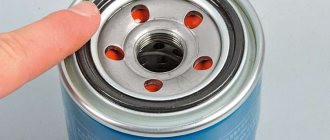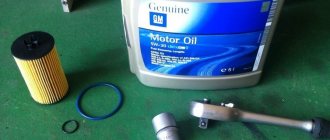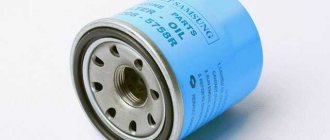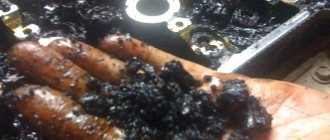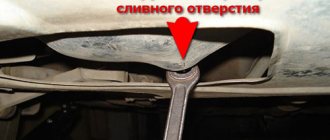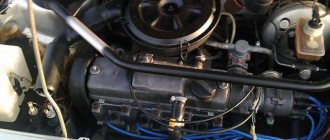Chevrolet Lacetti from the South Korean company GM Daewoo, which appeared in Russia in 2004, went on sale in five different trim levels: Plus, Star, Elite, Premium and Platinum. Depending on the type of equipment, four types of engines and 3 types of gearboxes were installed on the car. All engines are sixteen-valve, volume: 1.4, 1.6, 1.8 liters complying with Euro 3 standards. And since 2007, cars have also appeared with a 2.0 TCi diesel unit with a power of 121 hp.
In this case, using the example of a Chevrolet Lacetti with a 1.6 engine, the engine oil was changed, and we will show how it happened in photo report format.
2199-5-08-07
Remove the oil filter.
We clean the filter seat on the cylinder block from dirt and oil drips.
Apply engine oil to the filter O-ring.
We wrap the oil filter by hand until the sealing ring comes into contact with the cylinder block. Then turn the filter another 3/4 turn to seal the connection.
Pour 3.75 liters of oil into the engine through the oil filler neck.
Screw the neck cap clockwise.
We start the engine for 1–2 minutes. We make sure that the indicator of insufficient (emergency) oil pressure in the engine in the instrument cluster has gone out and there are no leaks from under the plug and filter. If necessary, tighten the oil filter and drain plug.
We stop the engine, after a few minutes (so that the oil flows into the oil pan), check the oil level and bring it to normal.
[How to save money on Chevrolet Lacetti maintenance] [Chevrolet Lacetti maintenance at 15,000/75,000/105,000 km] [Chevrolet Lacetti maintenance at 30 thousand km] [Chevrolet Lacetti maintenance at 45 thousand km] [Maintenance of Chevrolet Lacetti at 60,000/120,000 km] [Maintenance of Chevrolet Lacetti at 90,000 km] [Do-it-yourself maintenance - general recommendations] [Safety rules for doing maintenance yourself] [Tools required for Chevrolet maintenance Lacetti]
Replacing engine oil and oil filter Chevrolet Lacetti
Leaks and problems
The longer the Chevrolet Lacetti's mileage increases, the more problems appear, as in principle in any car. Most often this is due to natural wear and tear of the engine, causing oil to burn. Although the manufacturer allows for a small consumption.
But on some engines oil appears in the spark plug wells; this is a fairly common problem. The reason for this lies in the valve cover gasket, as well as the sealant that has lost its elasticity.
Therefore, to eliminate leakage into the spark plug wells, we change the valve cover gasket. After first removing the old sealant and cleaning the seating surface with a cleaner.
When carrying out this procedure, it should be taken into account that the sealing rings under the bolts require replacement. The original ones are expensive, so you can look for one from Kamaz, article number 7401003040. They are suitable for many engines of this model.
But in case of a big burn, you should pay attention to the oil scraper rings, most likely they are stuck. In this case, if decarbonization helps, it will not be for long, especially since there is a possibility of clogging the thin oil channels.
If it turns out that oil has flowed through the breather, then this may also indicate a problem with the rings or piston. The piston rings begin to leak exhaust gases that enter the engine crankcase. After which, mixed with oil, they rise into the breather. In this case, the most effective way is capital with replacement of rings.
All this is general information, which may manifest itself differently on each specific vehicle, since everyone’s operating modes are different. The same applies to leak locations; it is impossible to identify the cause from a distance.
Replacing transmission fluid
Chevrolet Lacetti is available with manual and automatic transmission, depending on the configuration. We will look at how to change the oil composition in a manual transmission (manual transmission). To do this you need to purchase and prepare:
- oil viscosity 75W90, GL4, 2 liters;
- gasket for the pallet, sealant for it;
- a large syringe or watering can with a hose;
- container for draining waste;
- rags and metal brush;
- a set of keys.
Before work, you should drive the car 5–10 kilometers to warm up the gearbox. Then the car is driven onto an overpass or into a viewing hole.
- The engine protection is removed. Then you need to find a breather with a protective cap, which is located near the pan. You need to remove the cap by pulling it up and unscrew it. This can be done with a 17 or 19 key - both heads are there.
- Now you need to loosen the bolts that secure the pallet. There may be 10 or 11 of them, depending on the modification. Therefore, you need to be careful when buying a pan gasket.
- The container is placed, on one side the tray is unscrewed and tilted. The grease is partially drained.
- The pan with remaining oil is completely removed. It is thoroughly cleaned, after which it can be washed with diesel fuel. Remaining chips are removed from the magnet. The old gasket is removed, the end surface is cleaned of the remnants of the old sealant.
- The small control plug for the lubricant level also needs to be unscrewed and cleaned.
- A new gasket is installed on the cover using sealant, then the pan is screwed back on. The inspection hole remains open.
- The oil mixture to be filled is pumped into the box body using a syringe.
- When the liquid flows through the control hole, the filling stops. The control plug and breather are screwed in. Then the tightness of the pan is checked.
At this point the work can be considered completed. The car is ready to drive for the next 60 thousand kilometers.
Do-it-yourself oil change for a Chevrolet Lacetti
14.12.2015
Do-it-yourself oil change for a Chevrolet Lacetti
Every 10,000 km, a mandatory oil change for the Chevrolet Lacetti is recommended. At the same time, solving this issue requires an individual approach, since the operating conditions for each vehicle are different. There are often cases when the oil is changed much more often due to difficult road conditions and increased load on the vehicle.
When to replace
The manufacturer's recommended replacement frequency is every 12.5 thousand km. mileage for engines up to 1.6 liters. and 15 thousand km. for units over 1.8 liters. At the same time, it is necessary to change the oil and filter in the Lacetti at least once a year, even if the specified mileage has not been reached.
These periods can be reduced to six months (up to 7.5 thousand km) under certain operating conditions:
- regular short distance driving;
- leaving the car at idle for a long time;
- driving on dirt roads and broken surfaces;
- increased loads when towing;
- frequent alternation of movement and stops;
- polluted dusty air;
- low quality fuel.
The above applies, first of all, to traffic in an urban environment, where short distances, constant traffic jams and a polluted environment lead to increased load. This is especially true in winter conditions, when for short periods the engine does not have time to warm up to normal operating temperature. Also, more frequent replacement will be required if you use low-quality oil.
Oil filter selection
As you know, the oil must be changed together with the oil filter. So, in this case, the ideal option would be the Korean Sewon filter with the original marking 96879797, approved by GM. As of 2022, the price of such a filter is 200 rubles.
Let's consider a few more options:
- Mann 712/22 is a German-made filter, ideal for Chevrolet Lacetti. It costs 180 rubles, that is, 20 rubles cheaper than the original.
- Bosch 0451 103 079 is another German filter produced in South Africa. Approximate price: 180 rubles.
- Hengst h90w03
- Fram PH 4722
Choosing the right oil for Lacetti, as well as recommended standards If you are guided by the original SAE viscosity standard, as well as the GM marking, in this case it is recommended to buy oil with a minimum amount of additives. As for the choice of this or that oil, it is impossible to give a definite answer. It all depends on the operating conditions, including the temperature outside the car. For example, for regions with warm climates, a product with a viscosity of OW-30 is suitable. The following oils correspond to this parameter:
- Elf Excellium Full-Tech - this oil is ideal for Lacetti with high mileage and a worn out engine. This product contains a minimum set of additives that quickly and effectively flush systems, eliminating the appearance of carbon deposits.
- Aral SuperTronic G is one of the most expensive, but at the same time the highest quality oils with an extremely low ash level
- Hundert Hight Tech is a European bestseller; in Russia it is rare Castrol EDGE - an expensive oil with a long service life. Optimal characteristics make it an excellent choice for Chevrolet Lacetti
Now let’s name the oils with the highest viscosity level:
- Liqui Moly Special LL
- Motul Specific LL A/B 025
- Teboil Diamond
- Comma Syner-Z
First of all, you need to pay attention to the viscosity and temperature indicators, and then the brand of oil. Naturally, this takes into account the climatic conditions in which the machine is operated, as well as the plant’s recommendations.
Choosing engine oil
As everyone knows, the lubricant in the engine needs to be changed periodically. According to the manufacturer's recommendation, an oil change on a Chevrolet Lacetti should be done every 10 thousand km. Unfortunately, reality makes its own adjustments. The life of the lubricant is affected by the quality of the fuel, which leaves much to be desired. In addition, dustiness, bad roads, and prolonged idling in traffic jams also force you to change the engine fluid earlier - after 7 or 8 thousand km.
What kind of oil should I use? You can use any oil you like for the Chevrolet Lacetti. The main thing is that it has approval GM-LL-A-025 for gasoline engines, GM-LL-B-025 for diesel engines, or the now common Dexos 2 (replacing both previous ones). In addition, the high-temperature viscosity must be equal to 30, and the category must not be lower than SL/CF according to the API classifier. If you take ACEA, there will be the following levels: A3/B4, C3. Here are some suitable products:
- GM Dexos 2 Longlife 5W-30;
- Liqui Moly SpecificLL A/B 025 5W30;
- Castrol Magnatec 5W-30 A3/B4.
There are many other brands of oils that can be poured into the Lazetti engine. The lubricants market today is huge, so the choice is yours.
In addition to the engine, the transmission fluid should be changed in gearboxes. Although the manufacturer claims that the lubricant is designed for the entire service life of the machine, it is better to replace it after 50–60 thousand km of travel.
There is also one condition here - that the oil for the Lacetti manual transmission meets the GL4 category of the API standard, and its viscosity, according to SAE, is 75W90. Many transmission oils are sold with such quality indicators.
Flushing the cooling system
Now, regarding alternative methods of flushing the cooling system. In addition to distilled water, three other methods are popular:
1. Special chemicals, which are sold in stores and markets. Personally, I don’t take risks, since I’ve seen a lot. The most recent case is that a neighbor washed the Vazovskaya Pyatnakha. The result is that the interior heater stopped heating. Now you need to get to the heater radiator. And whoever is in the know knows what it costs...
2. Rinse directly with tap water. Those. the hose from the water supply is lowered directly into the expansion tank, and the drain fitting on the radiator is left open and the water passes through the cooling system in a draft. I don't support this method either. First, water follows the path of least resistance and will not flush the entire system equally. And secondly, we have absolutely no control over what gets into the cooling system. Here is an example of a simple coarse filter in front of my counter
If any of this gets into the system, the pump may jam. And this is an almost guaranteed timing belt break...
3. Washing with citric acid and other traditional methods. See point one.
So my personal opinion is that it is better to reduce the antifreeze replacement interval than to engage in dubious activities.
Standards
- SAE is one of the parameters developed in the USA. It classifies modern and most popular oils. In addition, for the Chevrolet Lacetti model, SAE oil with a temperature viscosity of 5W30 or 5W40 is more suitable.
- API is another standard also regulated in the US. This standard includes two categories of oil - S (for gasoline internal combustion engines) and C (for diesel engines). In addition to these designations, for Chevrolet Lacetti you can use a product with a marking of at least SM.
- ACEA is a European standard, somewhat similar to the American API. This standard regulates European environmental standards and engine features, as well as the properties of oils. For example, for the European version of Lacetti, oil marked ACEA A3/B3 or A3/B4 is suitable. The product is certified for all-season use and is suitable for powerful and injection engines.
Checking the oil level and adding oil
During operation of the Chevrolet Lacetti, periodic checking of the oil level in the power plant and its topping up is required. To do this, use the instructions below.
- If the engine is hot, wait until it cools down.
- Pull out the dipstick.
- Wipe with a clean cloth.
- Insert the dipstick into place.
- Remove the meter again.
- Check the oil level. It must correspond to the area between the MIN and MAX marks.
- If the level is below or close to MIN, then it is necessary to add oil of the same brand. To do this, unscrew the oil filler plug.
- Add oil.
- Check the lubricant level.
- Close the oil filler neck.
Expansion tank Lacetti
As soon as the water comes out of the tank after washing, then you can immediately dismantle it so as not to waste time. While the remaining water drains, you will easily have time to wash the tank.
To do this, use pliers to move the quick-release clamps securing the hoses to the tank and disconnect the hoses
There are only three hoses. We disconnect them and unscrew the two nuts securing the tank with a 10mm wrench.
Then forcefully lift the tank up and remove it.
Here are the mounting locations for the tank:
The mounting studs are circled, and the arrow shows the bracket onto which the tank fits tightly.
We wash the tank. Cleaning products for plumbing fixtures (toilets, etc.) help me with this. In particularly dirty cases, when oil has gotten into the coolant, you will have to wash it out with more aggressive means, even gasoline.
We install the tank in place.
Note. Do not lubricate the tank fittings with any lubricants. Even better, degrease them. The fact is that in the cooling system the pressure is higher than atmospheric pressure and hoses can fly off from lubricated or simply greasy fittings and the clamps will not hold them. A sudden leak of coolant can lead to dire consequences.
